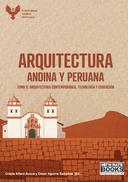Explore

Arquitectura Andina Y Peruana
Alhelí Estela Álvarez Huamán, Anjhela Rosa Callo MamanI, Crayla Alfaro Aucca (editor), Daniel Teran Loaiza, David Leoncio Durand Galindo, Efrain Ugarte-Salva, Grecia Anya Vargas Cruzado, Heiner Chachayma Zuñiga, Howard Albert Callo Mamani, Lenin John Meléndez Rodríguez, Marco Serna Cuba, Paola Gabriela Torres Palomino, Pool Carrión Mainicta, Raysha Quillahuamán Mendoza, Sophya Ayme Ramos, Victor Manuel Salas Velasquez, Yendi Medina Palacios, César Aguirre Zamalloa (editor), Universidad Andina del Cusco (editor)
2025
0 Ungluers have
Faved this Work
Login to Fave
The collective book Andean and Peruvian Architecture, Volume II: Contemporary Architecture, Technology, and Education brings together research that explores the relationship between architecture, society, education, and sustainability, offering critical perspectives and innovative
proposals derived from formative research carried out at the Andean University of Cusco. The volume opens with Fragmented Urubamba: Four
Urban-Architectural Perspectives that Rewrite Reality, by Efraín Ugarte-Salva and collaborators, which examines processes of territorial and urban
fragmentation in the Sacred Valley, proposing alternative readings to understand and transform the city’s architectural dynamics. Next, Impact of
Architectural Spaces on the Well-Being and Academic Experience of University Students, by Howard Callo and his team, analyzes how the spatial
quality of university environments affects student performance, motivation, and well-being. In Can the Vernacular Contribute to the Development
of Contemporary Architectures and Settlements?, Víctor Salas reflects on the value of traditional building practices as input for contemporary design, emphasizing the relevance of ancestral knowledge in addressing current challenges. Meanwhile, Dispute Prevention and Resolution Board:
Gaps in Law 32069 in Environmental Matters, by David Durand, offers a legal-architectural approach that highlights regulatory gaps in resolving
environmental conflicts. The pedagogical dimension is addressed in Academic Motivation and Learning Strategies in Architecture Students in
the Pre-Pandemic Context, by Crayla Alfaro, and in Educating to Design and Designing to Transform: Principles of a Transformative Architectural
Pedagogy, by Lenin Meléndez and Grecia Vargas, which propose pathways to strengthen disciplinary teaching. Finally, Unwanted Loneliness and
Public Space, by Alhelí Álvarez, presents methodological and inclusive urban design guidelines aimed at mitigating social isolation through architecture and public space. This volume represents a significant academic contribution that articulates applied research, pedagogical innovation,
and critical reflection, reaffirming the role of architecture as a discipline capable of influencing social and territorial transformation.
This book is included in DOAB.
Why read this book? Have your say.
You must be logged in to comment.
Rights Information
Are you the author or publisher of this work? If so, you can claim it as yours by registering as an Unglue.it rights holder.Downloads
This work has been downloaded 0 times via unglue.it ebook links.
- 0 - pdf (CC BY) at cdn.prod.website-files.com.
Keywords
- AM
- AMCR
- AMK
- architectural education
- Contemporary Architecture
- sustainability
Links
DOI: 10.36881/ARQ2025IIEditions

